International Business in India
VerifiedAdded on 2023/04/20
|11
|2947
|437
AI Summary
This report focuses on key aspects of international business in India, including national resources, FDI, trade policies, barriers for entry and exit, and factor endowments.
Contribute Materials
Your contribution can guide someone’s learning journey. Share your
documents today.

Running Head: ECONOMY 0
INTERNATIONAL BUSINESS
INDIA
DECEMBER 20, 2018
INTERNATIONAL BUSINESS
INDIA
DECEMBER 20, 2018
Secure Best Marks with AI Grader
Need help grading? Try our AI Grader for instant feedback on your assignments.

BUSINESS 1
Executive Summary
In this report, India is taken as a country due to the new emerging market where rapid GDP
growth attracts various investment from foreign countries due to various opportunities and
potential resources. This report focuses on many key aspects such as national resources, FDI,
trade policies, barriers for entry and exit, factor endowments and so on.
India is a country in South Asia, which has largest democracy in the world where the
constitution was, came into force on 26 January 1950. The globalization policy came to India
in 1990 just after the liberalisation plan. The Republic of India is considered one of the
emerging superpowers of the world. For a developing economy kike that of India, FDI plays
a significant role in bridging the gap between domestic savings and investment so that
sustainable economic development can be taken out.
Executive Summary
In this report, India is taken as a country due to the new emerging market where rapid GDP
growth attracts various investment from foreign countries due to various opportunities and
potential resources. This report focuses on many key aspects such as national resources, FDI,
trade policies, barriers for entry and exit, factor endowments and so on.
India is a country in South Asia, which has largest democracy in the world where the
constitution was, came into force on 26 January 1950. The globalization policy came to India
in 1990 just after the liberalisation plan. The Republic of India is considered one of the
emerging superpowers of the world. For a developing economy kike that of India, FDI plays
a significant role in bridging the gap between domestic savings and investment so that
sustainable economic development can be taken out.
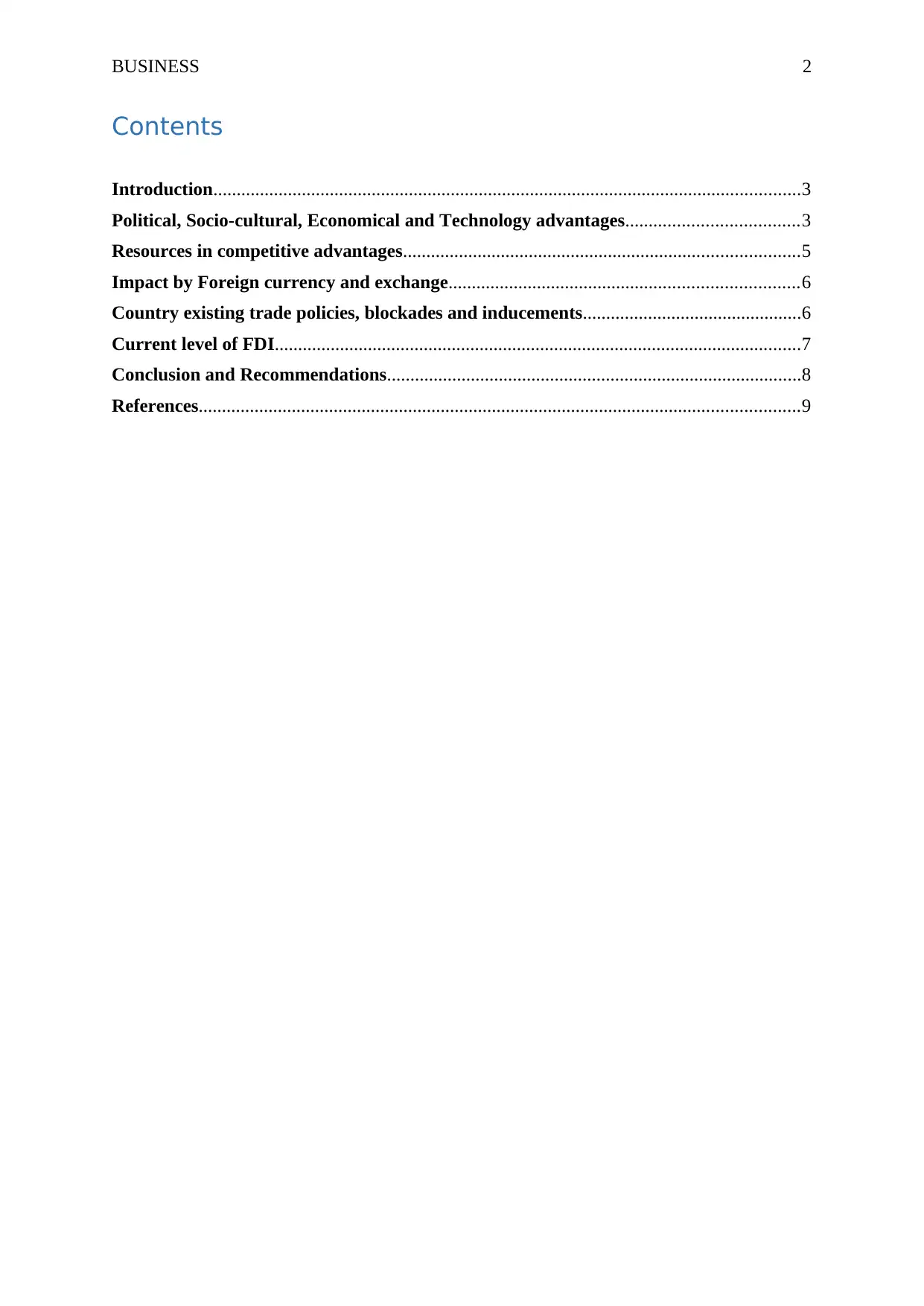
BUSINESS 2
Contents
Introduction..............................................................................................................................3
Political, Socio-cultural, Economical and Technology advantages.....................................3
Resources in competitive advantages.....................................................................................5
Impact by Foreign currency and exchange...........................................................................6
Country existing trade policies, blockades and inducements...............................................6
Current level of FDI.................................................................................................................7
Conclusion and Recommendations.........................................................................................8
References.................................................................................................................................9
Contents
Introduction..............................................................................................................................3
Political, Socio-cultural, Economical and Technology advantages.....................................3
Resources in competitive advantages.....................................................................................5
Impact by Foreign currency and exchange...........................................................................6
Country existing trade policies, blockades and inducements...............................................6
Current level of FDI.................................................................................................................7
Conclusion and Recommendations.........................................................................................8
References.................................................................................................................................9

BUSINESS 3
Introduction
The last two decade of the 20th century witnesses a dramatic global increase in the practices of
trading (Shah, Rao and Shankar, 2007). In India, the wave of liberalisation and globalisations
sweeping across the world has opened many national markets for multinational business.
Many big corporations play a major role in world trade and investments because of their
demonstrated technical skills, management knowledge, financial resources and various
related aspects. Recent developments in India are indicative of the rapidly growing
international business in the developing country. The economy in India is emerging
tremendously with inclusion of international investments, trade and financial transactions
along with the integration and openness of international markets (Zeschky, Widenmayer and
Gassmann, 2011).
India economy is the fastest growing economy in all over the world but it is framed by
various challenges and hurdles such as corruption, poverty and different cultures and beliefs.
It is the world seventh largest country as per the area and also has second largest standing
army.
Political, Socio-cultural, Economical and
Technology advantages
There are various factors, which affects the foreign direct investment in India. From past 10
years, the investment consequence is being continuously changing in India due to several
agreements and contracts in relation with privatisation, globalisation and liberalisation (Raja,
2016). India has substantial amounts of resources and ready to be employed in any sector so
as to contribute in the outflow and inflow of capital formation in their respective domain.
Moreover, the political environment is impacting these outflows and inflows and on various
areas such like telecommunication, insurance, banking and many more.
With the introduction of numerous reforms in 1991, there are many advantages come up for
India due to the FDI and political scenarios of the economy. This economic reform lead to the
initiation of several crucial policies related to import and export, licensing, franchising, etc.
This also brings rise in the technological sector as with FDI, many foreign firms get
autocratic rights and foreign equity. For instance, introduction of 51% FDI in retail sector,
Introduction
The last two decade of the 20th century witnesses a dramatic global increase in the practices of
trading (Shah, Rao and Shankar, 2007). In India, the wave of liberalisation and globalisations
sweeping across the world has opened many national markets for multinational business.
Many big corporations play a major role in world trade and investments because of their
demonstrated technical skills, management knowledge, financial resources and various
related aspects. Recent developments in India are indicative of the rapidly growing
international business in the developing country. The economy in India is emerging
tremendously with inclusion of international investments, trade and financial transactions
along with the integration and openness of international markets (Zeschky, Widenmayer and
Gassmann, 2011).
India economy is the fastest growing economy in all over the world but it is framed by
various challenges and hurdles such as corruption, poverty and different cultures and beliefs.
It is the world seventh largest country as per the area and also has second largest standing
army.
Political, Socio-cultural, Economical and
Technology advantages
There are various factors, which affects the foreign direct investment in India. From past 10
years, the investment consequence is being continuously changing in India due to several
agreements and contracts in relation with privatisation, globalisation and liberalisation (Raja,
2016). India has substantial amounts of resources and ready to be employed in any sector so
as to contribute in the outflow and inflow of capital formation in their respective domain.
Moreover, the political environment is impacting these outflows and inflows and on various
areas such like telecommunication, insurance, banking and many more.
With the introduction of numerous reforms in 1991, there are many advantages come up for
India due to the FDI and political scenarios of the economy. This economic reform lead to the
initiation of several crucial policies related to import and export, licensing, franchising, etc.
This also brings rise in the technological sector as with FDI, many foreign firms get
autocratic rights and foreign equity. For instance, introduction of 51% FDI in retail sector,
Secure Best Marks with AI Grader
Need help grading? Try our AI Grader for instant feedback on your assignments.
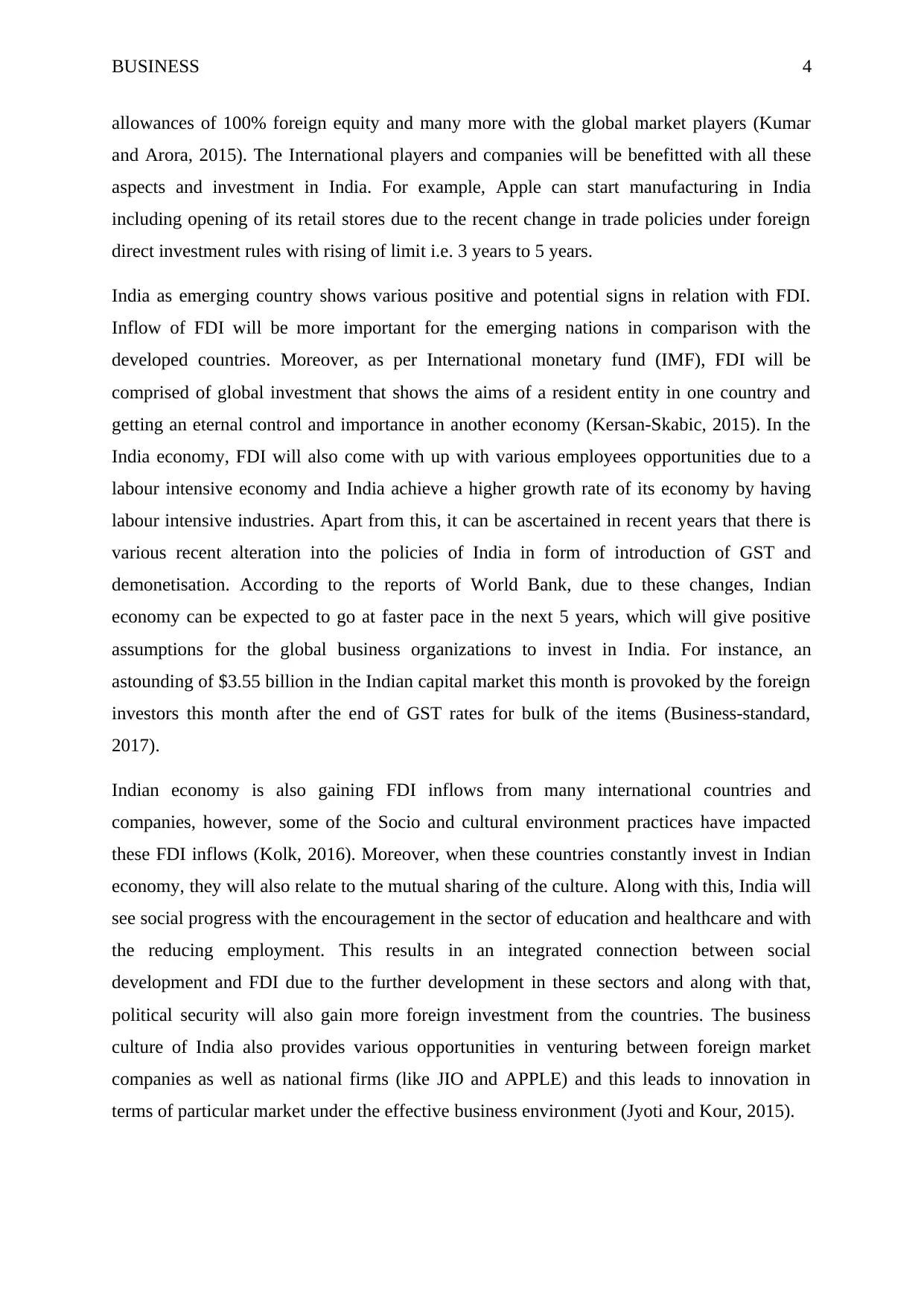
BUSINESS 4
allowances of 100% foreign equity and many more with the global market players (Kumar
and Arora, 2015). The International players and companies will be benefitted with all these
aspects and investment in India. For example, Apple can start manufacturing in India
including opening of its retail stores due to the recent change in trade policies under foreign
direct investment rules with rising of limit i.e. 3 years to 5 years.
India as emerging country shows various positive and potential signs in relation with FDI.
Inflow of FDI will be more important for the emerging nations in comparison with the
developed countries. Moreover, as per International monetary fund (IMF), FDI will be
comprised of global investment that shows the aims of a resident entity in one country and
getting an eternal control and importance in another economy (Kersan-Skabic, 2015). In the
India economy, FDI will also come with up with various employees opportunities due to a
labour intensive economy and India achieve a higher growth rate of its economy by having
labour intensive industries. Apart from this, it can be ascertained in recent years that there is
various recent alteration into the policies of India in form of introduction of GST and
demonetisation. According to the reports of World Bank, due to these changes, Indian
economy can be expected to go at faster pace in the next 5 years, which will give positive
assumptions for the global business organizations to invest in India. For instance, an
astounding of $3.55 billion in the Indian capital market this month is provoked by the foreign
investors this month after the end of GST rates for bulk of the items (Business-standard,
2017).
Indian economy is also gaining FDI inflows from many international countries and
companies, however, some of the Socio and cultural environment practices have impacted
these FDI inflows (Kolk, 2016). Moreover, when these countries constantly invest in Indian
economy, they will also relate to the mutual sharing of the culture. Along with this, India will
see social progress with the encouragement in the sector of education and healthcare and with
the reducing employment. This results in an integrated connection between social
development and FDI due to the further development in these sectors and along with that,
political security will also gain more foreign investment from the countries. The business
culture of India also provides various opportunities in venturing between foreign market
companies as well as national firms (like JIO and APPLE) and this leads to innovation in
terms of particular market under the effective business environment (Jyoti and Kour, 2015).
allowances of 100% foreign equity and many more with the global market players (Kumar
and Arora, 2015). The International players and companies will be benefitted with all these
aspects and investment in India. For example, Apple can start manufacturing in India
including opening of its retail stores due to the recent change in trade policies under foreign
direct investment rules with rising of limit i.e. 3 years to 5 years.
India as emerging country shows various positive and potential signs in relation with FDI.
Inflow of FDI will be more important for the emerging nations in comparison with the
developed countries. Moreover, as per International monetary fund (IMF), FDI will be
comprised of global investment that shows the aims of a resident entity in one country and
getting an eternal control and importance in another economy (Kersan-Skabic, 2015). In the
India economy, FDI will also come with up with various employees opportunities due to a
labour intensive economy and India achieve a higher growth rate of its economy by having
labour intensive industries. Apart from this, it can be ascertained in recent years that there is
various recent alteration into the policies of India in form of introduction of GST and
demonetisation. According to the reports of World Bank, due to these changes, Indian
economy can be expected to go at faster pace in the next 5 years, which will give positive
assumptions for the global business organizations to invest in India. For instance, an
astounding of $3.55 billion in the Indian capital market this month is provoked by the foreign
investors this month after the end of GST rates for bulk of the items (Business-standard,
2017).
Indian economy is also gaining FDI inflows from many international countries and
companies, however, some of the Socio and cultural environment practices have impacted
these FDI inflows (Kolk, 2016). Moreover, when these countries constantly invest in Indian
economy, they will also relate to the mutual sharing of the culture. Along with this, India will
see social progress with the encouragement in the sector of education and healthcare and with
the reducing employment. This results in an integrated connection between social
development and FDI due to the further development in these sectors and along with that,
political security will also gain more foreign investment from the countries. The business
culture of India also provides various opportunities in venturing between foreign market
companies as well as national firms (like JIO and APPLE) and this leads to innovation in
terms of particular market under the effective business environment (Jyoti and Kour, 2015).
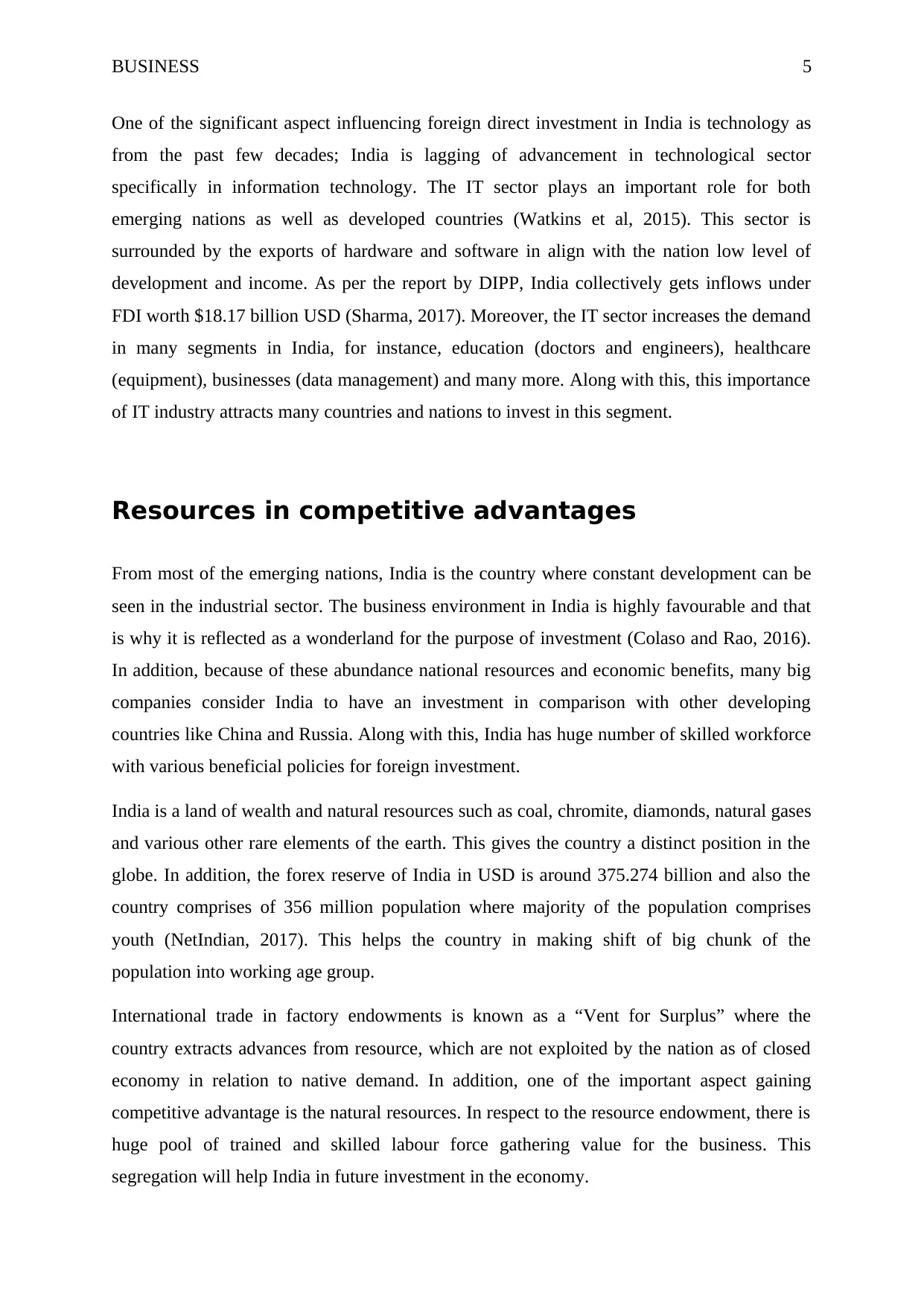
BUSINESS 5
One of the significant aspect influencing foreign direct investment in India is technology as
from the past few decades; India is lagging of advancement in technological sector
specifically in information technology. The IT sector plays an important role for both
emerging nations as well as developed countries (Watkins et al, 2015). This sector is
surrounded by the exports of hardware and software in align with the nation low level of
development and income. As per the report by DIPP, India collectively gets inflows under
FDI worth $18.17 billion USD (Sharma, 2017). Moreover, the IT sector increases the demand
in many segments in India, for instance, education (doctors and engineers), healthcare
(equipment), businesses (data management) and many more. Along with this, this importance
of IT industry attracts many countries and nations to invest in this segment.
Resources in competitive advantages
From most of the emerging nations, India is the country where constant development can be
seen in the industrial sector. The business environment in India is highly favourable and that
is why it is reflected as a wonderland for the purpose of investment (Colaso and Rao, 2016).
In addition, because of these abundance national resources and economic benefits, many big
companies consider India to have an investment in comparison with other developing
countries like China and Russia. Along with this, India has huge number of skilled workforce
with various beneficial policies for foreign investment.
India is a land of wealth and natural resources such as coal, chromite, diamonds, natural gases
and various other rare elements of the earth. This gives the country a distinct position in the
globe. In addition, the forex reserve of India in USD is around 375.274 billion and also the
country comprises of 356 million population where majority of the population comprises
youth (NetIndian, 2017). This helps the country in making shift of big chunk of the
population into working age group.
International trade in factory endowments is known as a “Vent for Surplus” where the
country extracts advances from resource, which are not exploited by the nation as of closed
economy in relation to native demand. In addition, one of the important aspect gaining
competitive advantage is the natural resources. In respect to the resource endowment, there is
huge pool of trained and skilled labour force gathering value for the business. This
segregation will help India in future investment in the economy.
One of the significant aspect influencing foreign direct investment in India is technology as
from the past few decades; India is lagging of advancement in technological sector
specifically in information technology. The IT sector plays an important role for both
emerging nations as well as developed countries (Watkins et al, 2015). This sector is
surrounded by the exports of hardware and software in align with the nation low level of
development and income. As per the report by DIPP, India collectively gets inflows under
FDI worth $18.17 billion USD (Sharma, 2017). Moreover, the IT sector increases the demand
in many segments in India, for instance, education (doctors and engineers), healthcare
(equipment), businesses (data management) and many more. Along with this, this importance
of IT industry attracts many countries and nations to invest in this segment.
Resources in competitive advantages
From most of the emerging nations, India is the country where constant development can be
seen in the industrial sector. The business environment in India is highly favourable and that
is why it is reflected as a wonderland for the purpose of investment (Colaso and Rao, 2016).
In addition, because of these abundance national resources and economic benefits, many big
companies consider India to have an investment in comparison with other developing
countries like China and Russia. Along with this, India has huge number of skilled workforce
with various beneficial policies for foreign investment.
India is a land of wealth and natural resources such as coal, chromite, diamonds, natural gases
and various other rare elements of the earth. This gives the country a distinct position in the
globe. In addition, the forex reserve of India in USD is around 375.274 billion and also the
country comprises of 356 million population where majority of the population comprises
youth (NetIndian, 2017). This helps the country in making shift of big chunk of the
population into working age group.
International trade in factory endowments is known as a “Vent for Surplus” where the
country extracts advances from resource, which are not exploited by the nation as of closed
economy in relation to native demand. In addition, one of the important aspect gaining
competitive advantage is the natural resources. In respect to the resource endowment, there is
huge pool of trained and skilled labour force gathering value for the business. This
segregation will help India in future investment in the economy.
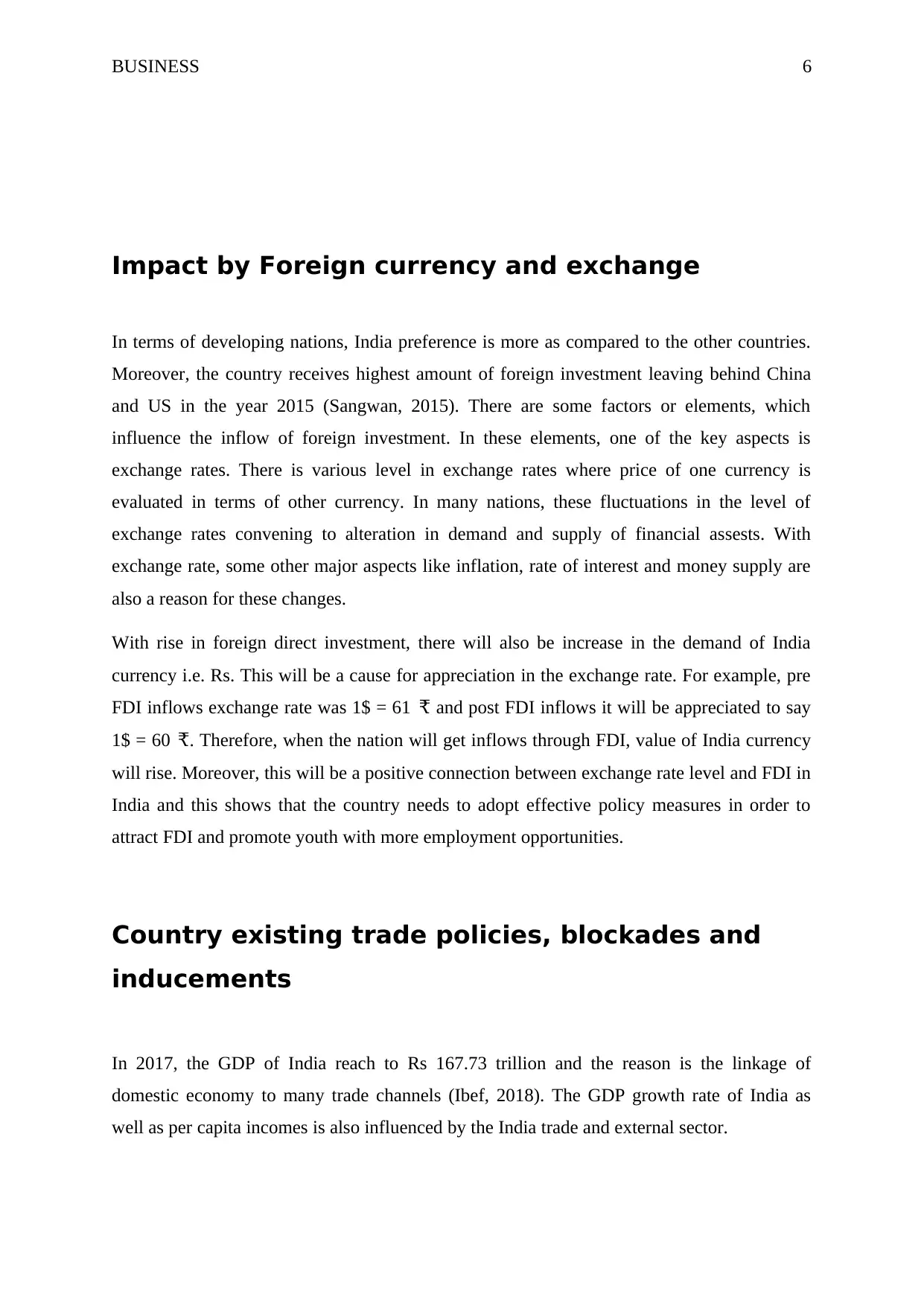
BUSINESS 6
Impact by Foreign currency and exchange
In terms of developing nations, India preference is more as compared to the other countries.
Moreover, the country receives highest amount of foreign investment leaving behind China
and US in the year 2015 (Sangwan, 2015). There are some factors or elements, which
influence the inflow of foreign investment. In these elements, one of the key aspects is
exchange rates. There is various level in exchange rates where price of one currency is
evaluated in terms of other currency. In many nations, these fluctuations in the level of
exchange rates convening to alteration in demand and supply of financial assests. With
exchange rate, some other major aspects like inflation, rate of interest and money supply are
also a reason for these changes.
With rise in foreign direct investment, there will also be increase in the demand of India
currency i.e. Rs. This will be a cause for appreciation in the exchange rate. For example, pre
FDI inflows exchange rate was 1$ = 61 and post FDI inflows it will be appreciated to say₹
1$ = 60 . Therefore, when the nation will get inflows through FDI, value of India currency₹
will rise. Moreover, this will be a positive connection between exchange rate level and FDI in
India and this shows that the country needs to adopt effective policy measures in order to
attract FDI and promote youth with more employment opportunities.
Country existing trade policies, blockades and
inducements
In 2017, the GDP of India reach to Rs 167.73 trillion and the reason is the linkage of
domestic economy to many trade channels (Ibef, 2018). The GDP growth rate of India as
well as per capita incomes is also influenced by the India trade and external sector.
Impact by Foreign currency and exchange
In terms of developing nations, India preference is more as compared to the other countries.
Moreover, the country receives highest amount of foreign investment leaving behind China
and US in the year 2015 (Sangwan, 2015). There are some factors or elements, which
influence the inflow of foreign investment. In these elements, one of the key aspects is
exchange rates. There is various level in exchange rates where price of one currency is
evaluated in terms of other currency. In many nations, these fluctuations in the level of
exchange rates convening to alteration in demand and supply of financial assests. With
exchange rate, some other major aspects like inflation, rate of interest and money supply are
also a reason for these changes.
With rise in foreign direct investment, there will also be increase in the demand of India
currency i.e. Rs. This will be a cause for appreciation in the exchange rate. For example, pre
FDI inflows exchange rate was 1$ = 61 and post FDI inflows it will be appreciated to say₹
1$ = 60 . Therefore, when the nation will get inflows through FDI, value of India currency₹
will rise. Moreover, this will be a positive connection between exchange rate level and FDI in
India and this shows that the country needs to adopt effective policy measures in order to
attract FDI and promote youth with more employment opportunities.
Country existing trade policies, blockades and
inducements
In 2017, the GDP of India reach to Rs 167.73 trillion and the reason is the linkage of
domestic economy to many trade channels (Ibef, 2018). The GDP growth rate of India as
well as per capita incomes is also influenced by the India trade and external sector.
Paraphrase This Document
Need a fresh take? Get an instant paraphrase of this document with our AI Paraphraser

BUSINESS 7
After the globalization, the economy of India is opened for the other countries, but it tariffs
continue to raise in relation with the other countries, although the policies are still restraining
other markets to enter fully. India was very restrictive before 1990s but trade reforms
initiated in India after liberalising certain aspects of policies and result can be seen in India
with in last 10 years. In addition, various policies relating to trade and investment are
changed by the government so that to prevent ‘producers’ to benefit ‘customers’. Concluding
all these aspects, India is rapidly moving towards becomes a developed economy and it will
be one of the major country in the world to push mode liberal global trade regime majorly in
terms of services.
With these benefits, there are some barriers also for India in relation with FDI such as the
growth of the country is affected by lack of infrastructure, complex economic reforms
because of slow administrative practices at central level, rigid labour laws, problems related
to poverty and corruption, and pressure of political parties at all levels of business stages.
Along with all this, the government of India provide inducement to various foreign
manufacturing organizations to setup in SEZ (Special Economic Zones) including relief in
taxation with various segments (Moberg, 2015). Each state in India have their own practices
and policies and thus offers several enticements (subsidised land, long-term loans, and many
more). Central and State government provide long and medium term loan to the foreign
market players.
Current level of FDI
As per the report of INCTAD, the rank of India is among the top 10 host economies in terms
of FDI. The inflow (in FDI) was USD 44.5 billion in 2016 but in 2017, it was declined to
USD 39.9 billion due to the changes of various policies by the government in relation with
GST, and Demonetisation of currency (Nordeatrade, 2018). This downward trend affects
negatively to the India economy for short period.
In 2018, some necessary amendments were also introduced in relation with FDI policy where
87 FDI rules among 21 sectors were simplified by the government so as to gain more inflow
of FDI from several countries.
After the globalization, the economy of India is opened for the other countries, but it tariffs
continue to raise in relation with the other countries, although the policies are still restraining
other markets to enter fully. India was very restrictive before 1990s but trade reforms
initiated in India after liberalising certain aspects of policies and result can be seen in India
with in last 10 years. In addition, various policies relating to trade and investment are
changed by the government so that to prevent ‘producers’ to benefit ‘customers’. Concluding
all these aspects, India is rapidly moving towards becomes a developed economy and it will
be one of the major country in the world to push mode liberal global trade regime majorly in
terms of services.
With these benefits, there are some barriers also for India in relation with FDI such as the
growth of the country is affected by lack of infrastructure, complex economic reforms
because of slow administrative practices at central level, rigid labour laws, problems related
to poverty and corruption, and pressure of political parties at all levels of business stages.
Along with all this, the government of India provide inducement to various foreign
manufacturing organizations to setup in SEZ (Special Economic Zones) including relief in
taxation with various segments (Moberg, 2015). Each state in India have their own practices
and policies and thus offers several enticements (subsidised land, long-term loans, and many
more). Central and State government provide long and medium term loan to the foreign
market players.
Current level of FDI
As per the report of INCTAD, the rank of India is among the top 10 host economies in terms
of FDI. The inflow (in FDI) was USD 44.5 billion in 2016 but in 2017, it was declined to
USD 39.9 billion due to the changes of various policies by the government in relation with
GST, and Demonetisation of currency (Nordeatrade, 2018). This downward trend affects
negatively to the India economy for short period.
In 2018, some necessary amendments were also introduced in relation with FDI policy where
87 FDI rules among 21 sectors were simplified by the government so as to gain more inflow
of FDI from several countries.
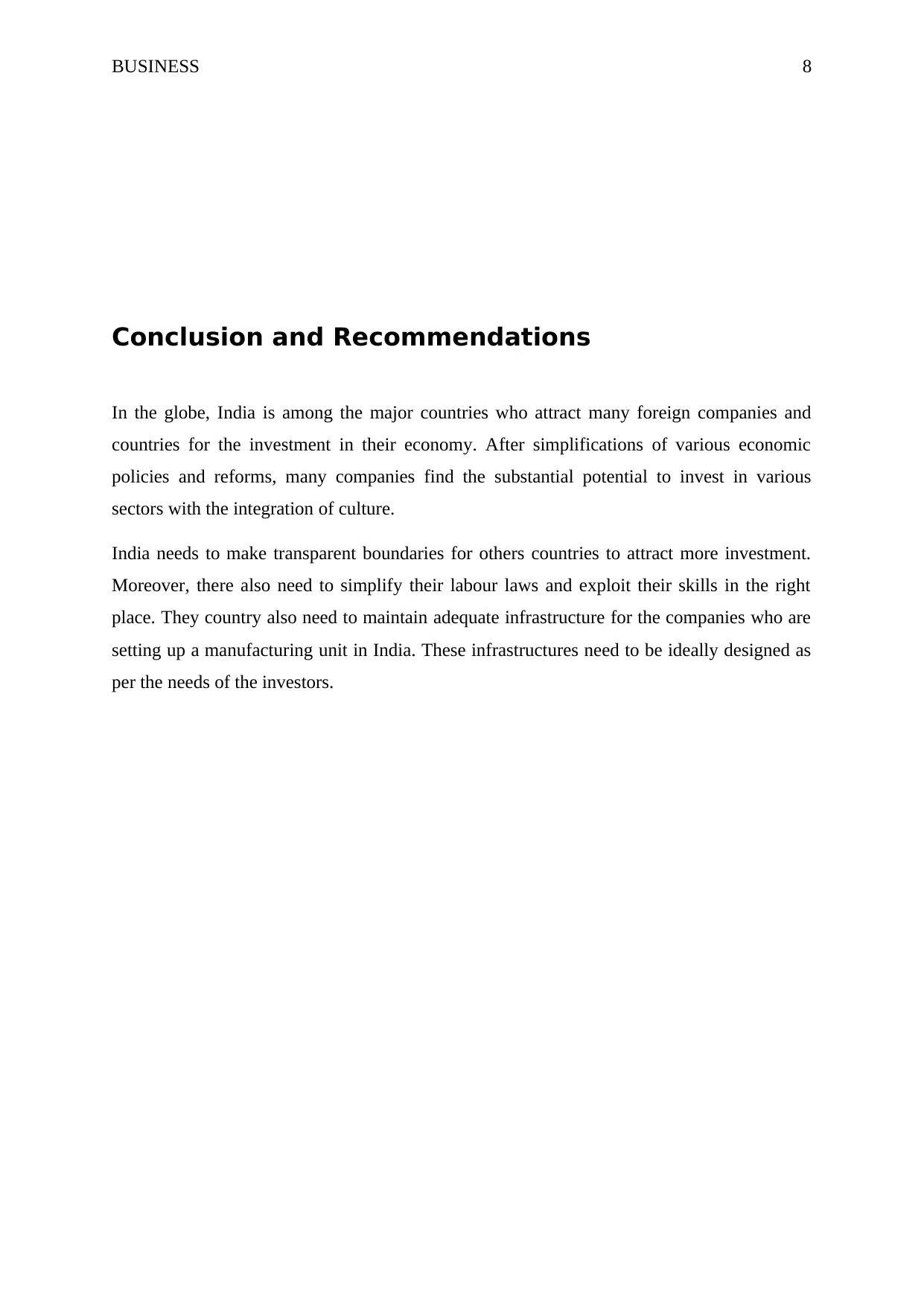
BUSINESS 8
Conclusion and Recommendations
In the globe, India is among the major countries who attract many foreign companies and
countries for the investment in their economy. After simplifications of various economic
policies and reforms, many companies find the substantial potential to invest in various
sectors with the integration of culture.
India needs to make transparent boundaries for others countries to attract more investment.
Moreover, there also need to simplify their labour laws and exploit their skills in the right
place. They country also need to maintain adequate infrastructure for the companies who are
setting up a manufacturing unit in India. These infrastructures need to be ideally designed as
per the needs of the investors.
Conclusion and Recommendations
In the globe, India is among the major countries who attract many foreign companies and
countries for the investment in their economy. After simplifications of various economic
policies and reforms, many companies find the substantial potential to invest in various
sectors with the integration of culture.
India needs to make transparent boundaries for others countries to attract more investment.
Moreover, there also need to simplify their labour laws and exploit their skills in the right
place. They country also need to maintain adequate infrastructure for the companies who are
setting up a manufacturing unit in India. These infrastructures need to be ideally designed as
per the needs of the investors.
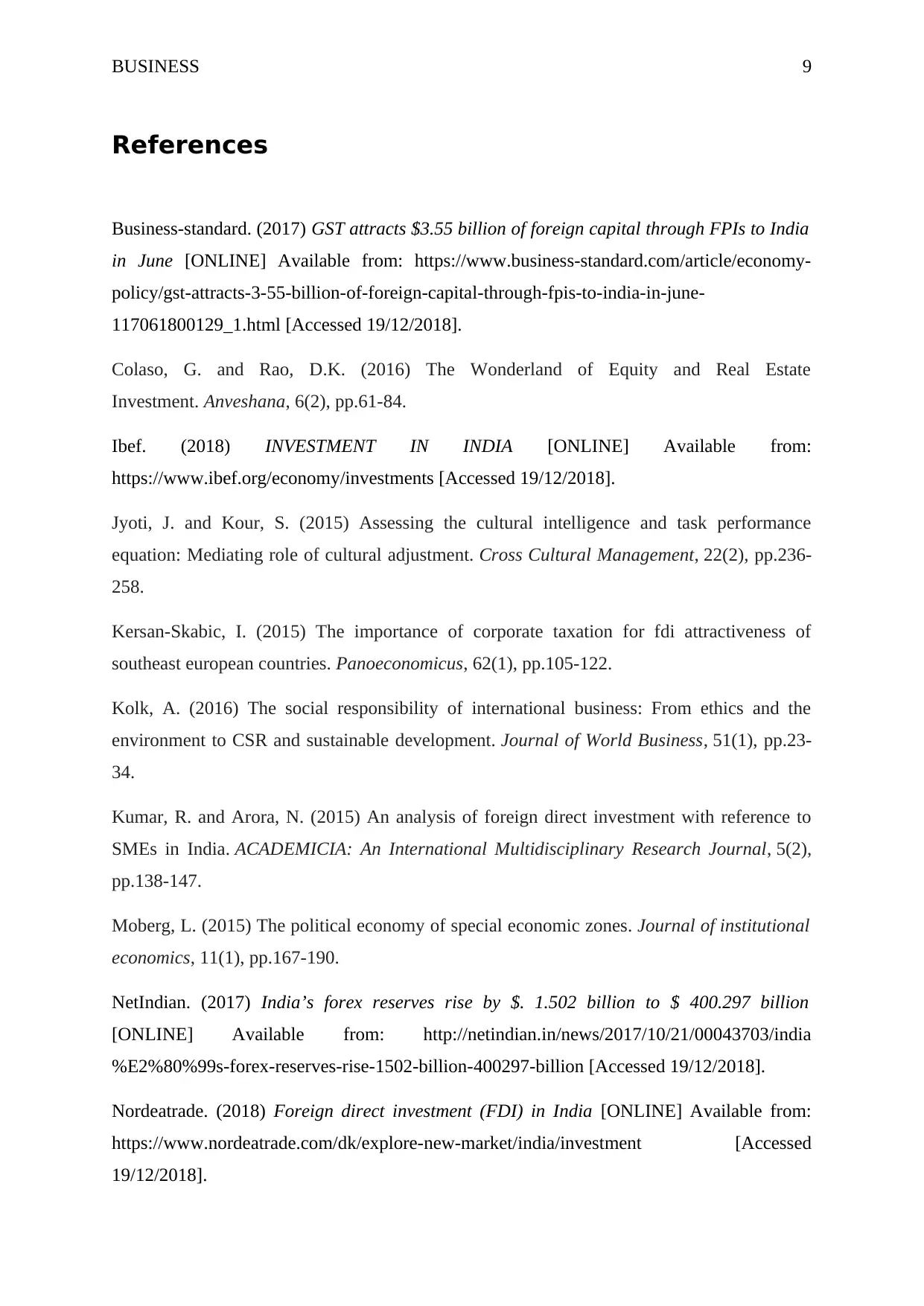
BUSINESS 9
References
Business-standard. (2017) GST attracts $3.55 billion of foreign capital through FPIs to India
in June [ONLINE] Available from: https://www.business-standard.com/article/economy-
policy/gst-attracts-3-55-billion-of-foreign-capital-through-fpis-to-india-in-june-
117061800129_1.html [Accessed 19/12/2018].
Colaso, G. and Rao, D.K. (2016) The Wonderland of Equity and Real Estate
Investment. Anveshana, 6(2), pp.61-84.
Ibef. (2018) INVESTMENT IN INDIA [ONLINE] Available from:
https://www.ibef.org/economy/investments [Accessed 19/12/2018].
Jyoti, J. and Kour, S. (2015) Assessing the cultural intelligence and task performance
equation: Mediating role of cultural adjustment. Cross Cultural Management, 22(2), pp.236-
258.
Kersan-Skabic, I. (2015) The importance of corporate taxation for fdi attractiveness of
southeast european countries. Panoeconomicus, 62(1), pp.105-122.
Kolk, A. (2016) The social responsibility of international business: From ethics and the
environment to CSR and sustainable development. Journal of World Business, 51(1), pp.23-
34.
Kumar, R. and Arora, N. (2015) An analysis of foreign direct investment with reference to
SMEs in India. ACADEMICIA: An International Multidisciplinary Research Journal, 5(2),
pp.138-147.
Moberg, L. (2015) The political economy of special economic zones. Journal of institutional
economics, 11(1), pp.167-190.
NetIndian. (2017) India’s forex reserves rise by $. 1.502 billion to $ 400.297 billion
[ONLINE] Available from: http://netindian.in/news/2017/10/21/00043703/india
%E2%80%99s-forex-reserves-rise-1502-billion-400297-billion [Accessed 19/12/2018].
Nordeatrade. (2018) Foreign direct investment (FDI) in India [ONLINE] Available from:
https://www.nordeatrade.com/dk/explore-new-market/india/investment [Accessed
19/12/2018].
References
Business-standard. (2017) GST attracts $3.55 billion of foreign capital through FPIs to India
in June [ONLINE] Available from: https://www.business-standard.com/article/economy-
policy/gst-attracts-3-55-billion-of-foreign-capital-through-fpis-to-india-in-june-
117061800129_1.html [Accessed 19/12/2018].
Colaso, G. and Rao, D.K. (2016) The Wonderland of Equity and Real Estate
Investment. Anveshana, 6(2), pp.61-84.
Ibef. (2018) INVESTMENT IN INDIA [ONLINE] Available from:
https://www.ibef.org/economy/investments [Accessed 19/12/2018].
Jyoti, J. and Kour, S. (2015) Assessing the cultural intelligence and task performance
equation: Mediating role of cultural adjustment. Cross Cultural Management, 22(2), pp.236-
258.
Kersan-Skabic, I. (2015) The importance of corporate taxation for fdi attractiveness of
southeast european countries. Panoeconomicus, 62(1), pp.105-122.
Kolk, A. (2016) The social responsibility of international business: From ethics and the
environment to CSR and sustainable development. Journal of World Business, 51(1), pp.23-
34.
Kumar, R. and Arora, N. (2015) An analysis of foreign direct investment with reference to
SMEs in India. ACADEMICIA: An International Multidisciplinary Research Journal, 5(2),
pp.138-147.
Moberg, L. (2015) The political economy of special economic zones. Journal of institutional
economics, 11(1), pp.167-190.
NetIndian. (2017) India’s forex reserves rise by $. 1.502 billion to $ 400.297 billion
[ONLINE] Available from: http://netindian.in/news/2017/10/21/00043703/india
%E2%80%99s-forex-reserves-rise-1502-billion-400297-billion [Accessed 19/12/2018].
Nordeatrade. (2018) Foreign direct investment (FDI) in India [ONLINE] Available from:
https://www.nordeatrade.com/dk/explore-new-market/india/investment [Accessed
19/12/2018].
Secure Best Marks with AI Grader
Need help grading? Try our AI Grader for instant feedback on your assignments.
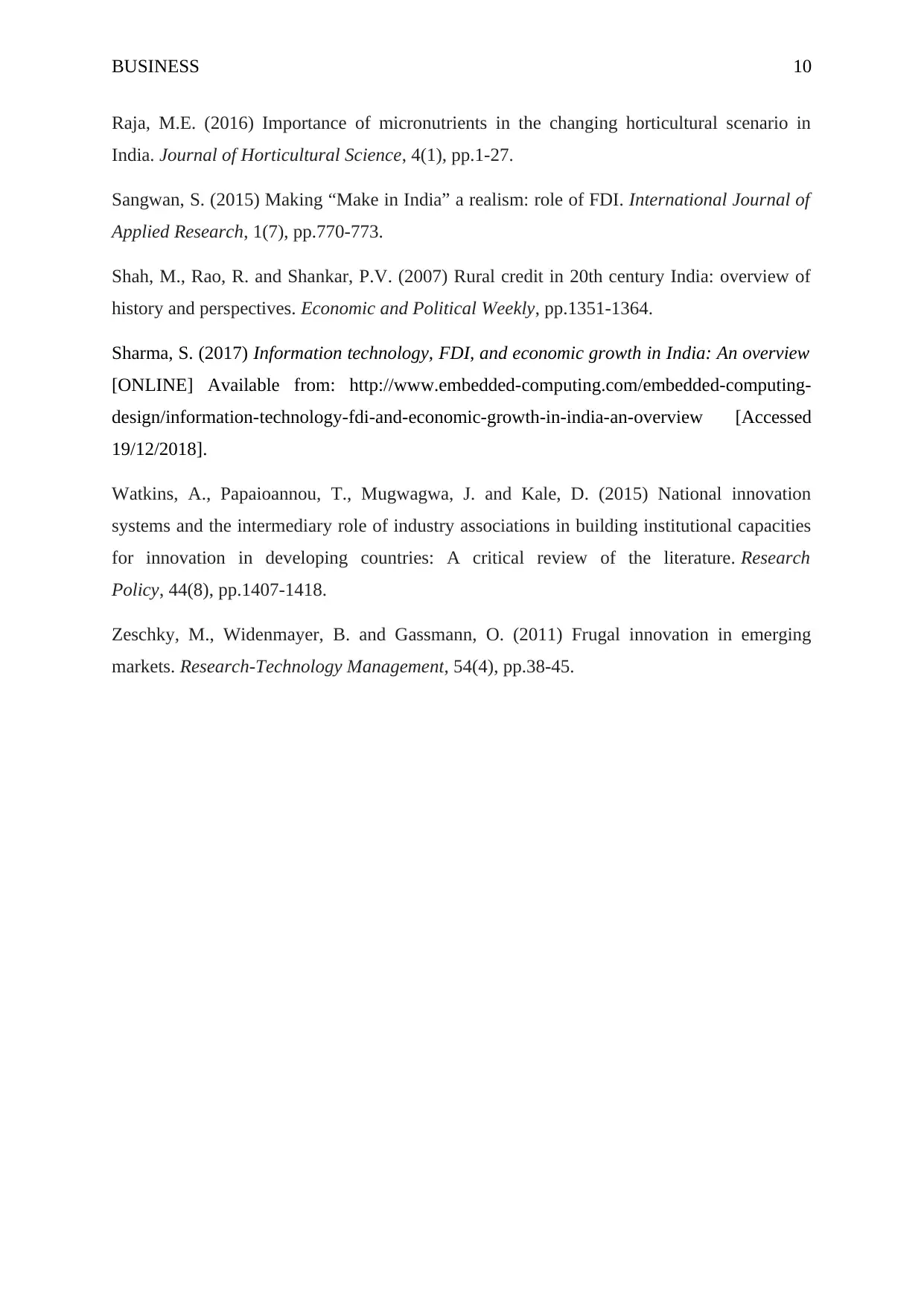
BUSINESS 10
Raja, M.E. (2016) Importance of micronutrients in the changing horticultural scenario in
India. Journal of Horticultural Science, 4(1), pp.1-27.
Sangwan, S. (2015) Making “Make in India” a realism: role of FDI. International Journal of
Applied Research, 1(7), pp.770-773.
Shah, M., Rao, R. and Shankar, P.V. (2007) Rural credit in 20th century India: overview of
history and perspectives. Economic and Political Weekly, pp.1351-1364.
Sharma, S. (2017) Information technology, FDI, and economic growth in India: An overview
[ONLINE] Available from: http://www.embedded-computing.com/embedded-computing-
design/information-technology-fdi-and-economic-growth-in-india-an-overview [Accessed
19/12/2018].
Watkins, A., Papaioannou, T., Mugwagwa, J. and Kale, D. (2015) National innovation
systems and the intermediary role of industry associations in building institutional capacities
for innovation in developing countries: A critical review of the literature. Research
Policy, 44(8), pp.1407-1418.
Zeschky, M., Widenmayer, B. and Gassmann, O. (2011) Frugal innovation in emerging
markets. Research-Technology Management, 54(4), pp.38-45.
Raja, M.E. (2016) Importance of micronutrients in the changing horticultural scenario in
India. Journal of Horticultural Science, 4(1), pp.1-27.
Sangwan, S. (2015) Making “Make in India” a realism: role of FDI. International Journal of
Applied Research, 1(7), pp.770-773.
Shah, M., Rao, R. and Shankar, P.V. (2007) Rural credit in 20th century India: overview of
history and perspectives. Economic and Political Weekly, pp.1351-1364.
Sharma, S. (2017) Information technology, FDI, and economic growth in India: An overview
[ONLINE] Available from: http://www.embedded-computing.com/embedded-computing-
design/information-technology-fdi-and-economic-growth-in-india-an-overview [Accessed
19/12/2018].
Watkins, A., Papaioannou, T., Mugwagwa, J. and Kale, D. (2015) National innovation
systems and the intermediary role of industry associations in building institutional capacities
for innovation in developing countries: A critical review of the literature. Research
Policy, 44(8), pp.1407-1418.
Zeschky, M., Widenmayer, B. and Gassmann, O. (2011) Frugal innovation in emerging
markets. Research-Technology Management, 54(4), pp.38-45.
1 out of 11
Related Documents
Your All-in-One AI-Powered Toolkit for Academic Success.
+13062052269
info@desklib.com
Available 24*7 on WhatsApp / Email
![[object Object]](/_next/static/media/star-bottom.7253800d.svg)
Unlock your academic potential
© 2024 | Zucol Services PVT LTD | All rights reserved.





